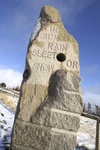|
Elliptical Recumbent Stone Circle; Widest diameter 16.6 metres, narrowest diameter 12.8 metres five erect stones including recumbent and E pillar, five prostrate stones including W pillar. They are set upon a bank of small stones and earth 1.92m x 0.76m. c14.4 m in diameter, with kerbs formed by slab-like stones on the inner and outer faces, it appears flat, however below the surface, the interior is made up, at least partially, of a mass of small boulders. It was a considerable feat to haul all the great stones of the ring, including the massive, whale-like recumbent (weighing 21 tons), into position on this bank. Such banks are a particular feature of recumbent Stone circles in Buchan.
An arc of monoliths runs out from the fallen west flanker; the southern and central ones were perhaps selected for their distinctly phallic shape. These stones are exceptionally tall: the cast flanker stands 2.23 m high and its fallen partner on the west is 2.86 m long. Clear signs that the seven stones of the ring were graded in height can still be seen.
Most of the stones are of granite, but the fallen west flanker and the recumbent are of whinstone. The latter, 4.6 m long is rather uneven over its upper surface, yet overall quite level; it is beaked at the west end for ease of levering into position, but very straight at the east.
A very atmospheric site.
More Information
|
|
An inspired contemporary gravestone, by Helen Denerley, with a brass and copper relief appliqué in the form of the tree of life in a sinuous style. A mouse and a lizard are nestled among the tree's roots.
More Information
|






























